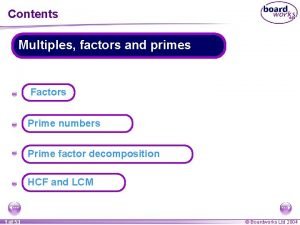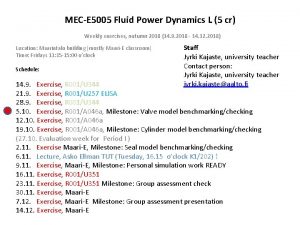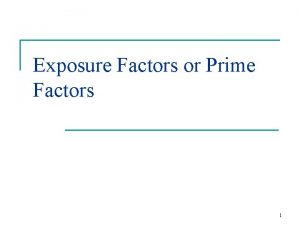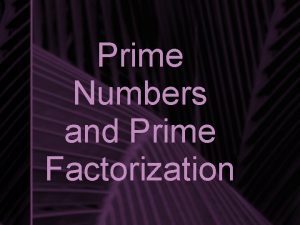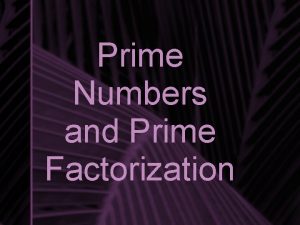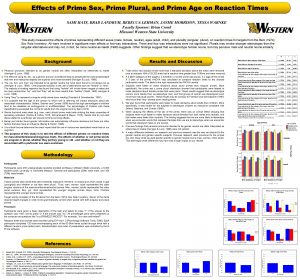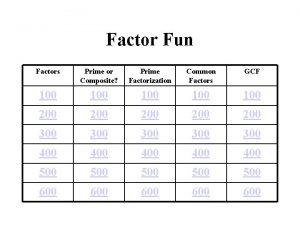Chapter 11 Prime Factors Prime Factors Prime factors


















- Slides: 18

Chapter 11 Prime Factors

Prime Factors • Prime factors: affect x-ray emission; under the control of the radiographer. – Miliamperage-second (m. As) – Kilovoltage (k. Vp) – Distance (d) • Related to tube design and construction. – – Tube housing Target material Filtration Voltage waveform

X-Ray Quantity • X-ray quantity: measure of the number of x-ray photons in the useful beam. – AKA x-ray output, intensity, or exposure – Unit Roentgen (R) – Directly affected by: • Miliamperage-second (m. As) • Kilovoltage (k. Vp) • Distance (d)

X-ray quality • X-ray quality: measurement of the penetrating ability of the x-ray beam. • Describes the distance an x-ray beam travels in matter. – High energy x-ray photons travel farther in matter- more penetrating • Numerically represented by the Half-value layer (HVL).

Half-Value Layer • Half-value layer of an x-ray beam is that thickness of absorbing material needed to reduce the x-ray intensity to half its original value. • Affected by: – Kilovoltage – Filtration • Not controlled from exposure to exposure

Milliamperage • Milliamperage (m. A): measurement of xray tube current. – The number of electrons crossing the tube from cathode to anode per second – Directly proportional to tube current • Ampere: equal to an electrical charge of 1 coulomb flowing through a conductor per second. • 1 Coulomb = 6. 3 x 1018 electron charges.

Exposure • Exposure time is directly proportional to the number of electrons crossing the tube and is therefore directly proportional to the number of xrays created. • The number of x-rays that will be created at the target is a product of the number of electrons crossing the tube (tube current) and how long the electrons are allowed to cross (exposure time). • Measured in m. As- primary controller of x-ray quantity.

Density Relationship to m. As • Radiographic film density is the degree of blackening of an x-ray film – Created by deposits of black metallic silver on an x-ray film that has been exposed to light or x-ray and then processed – Densities are the result of an x-ray exposure to the film and intensifying screens. • Film density is determined by the amount of silver deposition in the emulsion due to: – – Film type Exposure conditions Exposure (m. R) Processing

Density Relationship to m. As • If the exposure to a film is increased, the density to that film will increase until the point where the film reached its maximum density (Dmax). • m. As is used as the primary controller of radiographic film density. • By maintaining a specific exposure relative to the speed of the image receptor, consistent film density can be achieved.

Reciprocity Law • The reaction of a photographic film to light is equal to the product of the intensity of the light and the duration of the exposure. • The density on the x-ray film should remain unchanged as long as the intensity and duration of the x-ray exposure remains unchanged. – Fails for exposures made at extremely short exposure times (less than 1/100 second) or extremely long exposure times (more than a second) • Law failure in not very significant in diagnostic radiology because exposures are seldom at those extremes

Kilovoltage • Increasing the kilovoltage on an x-ray control panel will cause an increase in the speed and energy of the electrons applied across the x-ray tube. – Increased energy of the electrons results in the production of x-ray photons with greater energy. • Controls both the quantity and quality of the xray beam. – Quantity: more interactions will occur at the target as k. Vp increases. – Quality: each electron has more energy resulting in a beam with greater penetrability

Density Relationship to k. Vp • Changes in kilovoltage create changes in beam penetrability. • k. Vp is the primary controller of the differences in radiographic density. – k. Vp should NOT be used to control radiographic film density (contrast) • As k. Vp increases, causes increase in penetrability, which will result in less contrast.

15 percent rule • An increase in k. Vp by 15 percent will cause a doubling in exposure, the same effect as doubling the m. A or doubling exposure time. • Hypothetically, if k. Vp is doubled, the x-ray quantity would increase by a factor of four, but this does not take into account the increased penetrability of the bean with increasing k. Vp. – As a result, radiographic density is more significantly affected. – To maintain exposure with changes in k. Vp, the 15 percent rule can be applied, – To maintain density, if the k. Vp is increased 15 percent, the m. As must be reduced to one-half its original value.

Distance • The intensity of x-rays varies greatly with changes in distance. • Measurement of the x-ray intensity is obtained using a dosimeter. • X-ray photons are most concentrated at the target and from there they spread out in all directions. – X-ray intensity (quantity) begins to diminish. • Photons that exit the tube port constitute the primary useful beam.

Inverse Square Law • Intensity of radiation at a given distance from the point source is inversely proportional to the square of the distance. I 1 / I 2 = D 22 / D 12 I 1 = original intensity I 2 = new intensity D 22 = original distance D 12 = new distance

Distance Relationship to Distance • As the distance increases, intensity decreases which causes a decrease in exposure to the image receptor. • Since m. As is the primary controller of xray intensity and radiographic film density, m. As can be adjusted to compensate for changes in distance.

Exposure (film density) maintenance formula • m. As should increase proportionally to the square of the change when distance increases. (direct square law) m. As 1 / m. As 2 = D 12 / D 22 m. As 1 = original m. As 2 = New m. As D 22 = original distance D 12 = new distance

Density Relationship to m. As, k. Vp & d • The radiographer should select the k. Vp based on the desired contrast, and adjust m. As to provide the appropriate total exposure to the receptor.
 Jeff bezos prime video prime
Jeff bezos prime video prime Factorial in casio calculator
Factorial in casio calculator 420 as a product of prime factors in index form
420 as a product of prime factors in index form Gcf of 42 and 84
Gcf of 42 and 84 Factor tree of 108
Factor tree of 108 Prime and composite jeopardy
Prime and composite jeopardy Factors of 72
Factors of 72 Hcf lcm worksheet
Hcf lcm worksheet Prime factorization of 32
Prime factorization of 32 3 factors of 16
3 factors of 16 Prime factorization 120
Prime factorization 120 Highest common factor of 36 and 48
Highest common factor of 36 and 48 Prime factors of 24
Prime factors of 24 Factors of 78
Factors of 78 Gcf of 96 and 72
Gcf of 96 and 72 8-1 factors and greatest common factors
8-1 factors and greatest common factors 5005 prime factorization
5005 prime factorization Factors of 7
Factors of 7 Site vs situation factors
Site vs situation factors











